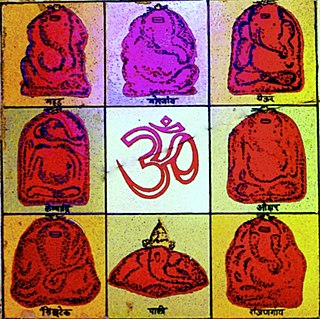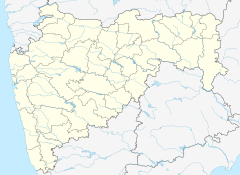
Ashtavinayaka is a Sanskrit term which means "eight Ganeshas". The Ashtavinayaka Yatra refers to a pilgrimage to the eight Hindu temples in the state of Maharashtra, India, centered around the city of Pune. The eight temples house eight distinct idols of Ganesha, the Hindu deity of unity, prosperity, learning, and removing obstacles. Each of these temples has its own individual legend and history, as distinct from each other as the murtis in each temple. The form of each murti of Ganesha and his trunk are distinct from one another. There are other temples of eight Ganesha in various other parts of Maharashtra; however, the ones around Pune are more well known and visited. To complete the Ashtavinayaka Yatra, one must revisit the first temple after visiting all the eight temples.

In Hindu scriptures, Durvasa, also known as Durvasas, is a legendary rishi (sage). He is the son of Anasuya and Atri. According to some Puranas, Durvasa is a partial avatar of Shiva, known for his short temper. Wherever he goes, he is received with great reverence by humans and devas alike.

Ganesh Chaturthi, also known as Vinayaka Chaturthi or Vinayaka Chavithi or Vinayagar Chaturthi, is a Hindu festival celebrating the birthday of Hindu deity Ganesh. The festival is marked with the installation of Ganesha's murtis privately in homes and publicly on elaborate pandals. Observances include chanting of Vedic hymns and Hindu texts, such as prayers and vrata (fasting). Offerings and prasada from the daily prayers, that are distributed from the pandal to the community, include sweets such as modak as it is believed to be a favourite of Ganesha. The festival ends on the tenth day after start, when the murti is carried in a public procession with music and group chanting, then immersed in a nearby body of water such as a river or sea, called visarjana on the day of Ananta Chaturdashi. In Mumbai alone, around 150,000 murtis are immersed annually.

Shakuntala is a celebrated heroine in Indian literature, best known for her portrayal in the ancient Sanskrit play Abhijnanashakuntalam, written by the classical poet Kalidasa in the 4th or 5th century CE. Her story, however, originates in the Hindu epic, the Mahabharata, where she appears in the Adi Parva. In both narratives, Shakuntala was the daughter of the renowned sage Vishwamitra and the celestial nymph Menaka. Abandoned at birth, she was raised by the sage Kanva in a forest hermitage. Years later, she fell in love with King Dushyanta and married him. After a series of misfortunes, she became the mother of Bharata, a celebrated emperor of India

Dushyanta is a king of the Chandravamsha (Lunar) dynasty featured in Hindu literature. He is the husband of Shakuntala and the father of Bharata. He appears in the Mahabharata and in Kalidasa's play, Abhijnanashakuntalam.

Abhijñānaśākuntalam, also known as Shakuntala, The Recognition of Shakuntala, The Sign of Shakuntala, and many other variants, is a Sanskrit play by the ancient Indian poet Kālidāsa, dramatizing the story of Śakuntalā told in the epic Mahābhārata and regarded as the best of Kālidāsa's works. Its exact date is uncertain, but Kālidāsa is often placed in the 4th century CE.
Titwala (Titvala) is a town near Kalyan in the Indian state of Maharashtra, Located in Thane District. Titwala is famous for the Siddhivinayak Mahaganapati Temple, where lakhs of devotees visit this temple to take auspicious blessings of Lord Ganesha during the auspicious days of Ganesh Chaturthi and Angarki Sankashti Chaturthi.

Varadvinayak, also spelt as Varadavinayaka, is one of the Ashtavinayak temples of the Hindu deity Ganesha. It is located in Mahad village situated in Khalapur taluka near Karjat and Khopoli of Raigad District, Maharashtra, India. The temple was built (restored) by Peshwa General Ramji Mahadev Biwalkar in 1725AD.

Bharata is a legendary emperor featured in Hindu literature. He is a member of the Chandravamsha dynasty, and becomes the Chakravarti. He is regarded to be the ancestor of the Pandavas, the Kauravas, Brihadhrata, and Jarasandha.
This article lists the traditional festivals and other cultural events in the Odisha region of India. Odisha celebrates 13 festivals in 12 months as the saying goes Bāra Māsare Tera Parba.
The Dashabhuja Temple is a Hindu temple in Pune, in the Maharashtra state of India. This temple was once owned by Sardar Haripant Phadke, a Sardar of Peshwa and was later donated to the Peshwas as dowry. Dashabhuja Ganapati temple is visited by thousands of devotees every day and the number increases during Ganesh Chaturthi. The idol of Ganpati or Ganesh seen here has his elephant trunk resting on his right-hand side, which is supposed to be rarer and more sacred than other forms of the Ganesh idol.

Chhatarpur Temple is a Hindu temple dedicated to the goddess Katyayani. The entire complex of the temple is spread over a wide area of 28 hectares. It is located in Chhatarpur, on the southwestern outskirts of the New Delhi. It is the 2nd largest temple in Delhi, after the Akshardham Temple. This temple is constructed from marble and on all of the facets there is jaali work. It can be classified a vesara style of architecture.

Ganesh Jayanti (literally "Ganesha's birthday", also known as Bhadra shukla chaturthi, Tilkund chaturthi, and Varad chaturthi, is a Hindu festival. This occasion celebrates the birth day of Ganesha, the lord of wisdom. It is a popular festival particularly in the Indian state of Maharashtra and it is also celebrated in Goa held during the shukla paksha chaturthi day in the month of Bhadra as per the Hindu calendar, which corresponds to the Gregorian calendar month of January/February. In 2022, Ganesh Jayanti falls on 4 February.

Shri Mayureshwar Mandir or Shri Moreshwar Temple is a Hindu temple (mandir) dedicated to Ganesha, god of wisdom. It is located in Moragaon in Pune District, about 65 km away from Pune city in the Indian state of Maharashtra. The temple is the starting and ending point of a pilgrimage of eight revered Ganesha temples called Ashtavinayaka.

Lalbaugcha Raja is the sarvajanik (public) Ganesha idol kept at Lalbaug, a locality in Mumbai in the Indian state of Maharashtra, during the Ganesh Chaturthi festival. The idol gives darshan to the devotees for 11 days; thereafter it is immersed in the Arabian Sea at Girgaon Chowpatty on the day of Anant Chaturdashi.

The Chintamani Temple of Theur is a Hindu temple dedicated to Supreme God Ganesha according to Ganapatya Sect located 25 km (16 mi) from Pune, the temple is "one of the larger and more famous" of the Ashtavinayaka, the eight revered shrines of Ganesha in the Indian state of Maharashtra.

The Vigneshwara Temple or Vighnahar Ganapati Temple of Ozar is a Hindu temple dedicated to Ganesha, the elephant-headed god of wisdom. The temple is one of the Ashtavinayaka, the eight revered shrines of Ganesha in Maharashtra, India. The Ganesha form worshipped here is called Vigneshwara or Vignahar and is associated with the legend of Ganesha defeating Vignasura, the demon of obstacles.

Shakuntala is a 1943 drama film based on Kālidāsa's Sanskrit drama Abhijñānaśākuntalam, directed by V. Shantaram. It was the first film made under the newly formed Rajkamal Kalamandir banner that Shantaram had started. It was the first film to be shown commercially in US. Adapted from the Shakuntala of Kalidas the screenplay was by Diwan Sharar. Music was composed by Vasant Desai with lyrics by Diwan Sharar and Ratan Piya. The cinematatography was by V. Avadhoot and the film starred Kumar Ganesh, Jayashree, Chandra Mohan, Ameena, Shantaram, Zohra and Nana Palsikar.

Durgadi Fort is a fort located in Kalyan, near Mumbai in Maharashtra, India.

Shaakuntalam is a 2023 Indian Telugu-language Mythological film romantic drama film written and directed by Gunasekhar. It is produced by Neelima Guna under Gunaa Teamworks and distributed by Sri Venkateswara Creations. Based on a popular play Abhignyana Shakuntalam by Kalidasa, the film features Samantha in the title role of Shakuntala and Dev Mohan as Dushyanta, the king of Puru dynasty along with Mohan Babu, Jisshu Sengupta, Madhoo, Gautami, Aditi Balan and Ananya Nagalla in supporting roles. In the film, Shakuntala and King Dushyant marry, but Dushyant forgets all about Shakuntala due to a sage's curse.





















